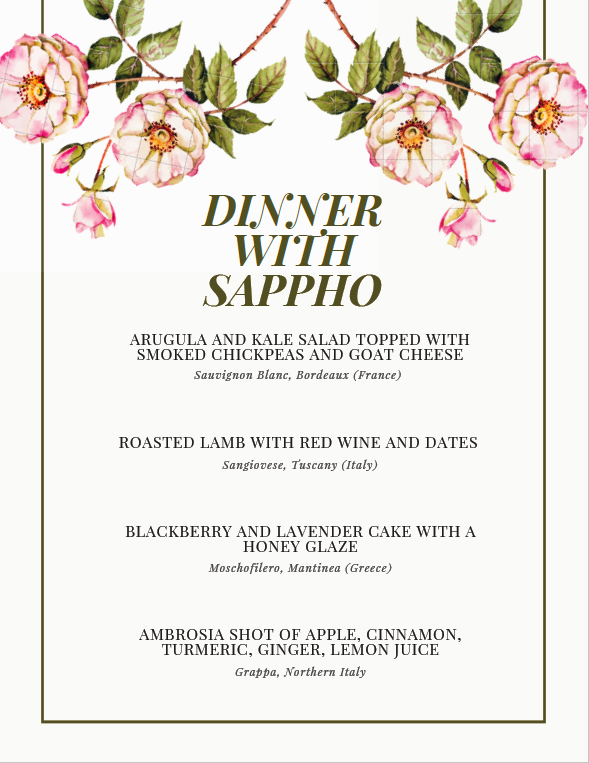48 A Dinner Party With Sappho
By: Angie, Cy, Juliana, and Miranda

Menu Theme
In concocting our Dinner with Sappho, we chose a series of dishes that we believed would either serve as the tasting sensory equivalent to reading Sappho’s poetry, that were inspired by Mediterranean recipes, or that centered ingredients drawn directly from the text. We also included wine pairings because wine is often discussed in Sappho’s work. Our menu endeavors to answer the question of what a dinner party with Sappho might actually taste like.
Course 1: Arugula and kale salad topped with smoked chickpeas and goat cheese
We wanted our first dish to be light and summery to match the Mediterranean climate and yet rich enough to whet the appetites of the attendees. Fresh greens seemed appropriate for a quiet, pastoral atmosphere, and we were set on incorporating chickpeas into this meal. Not only are they traditionally used in Greek cuisine, but Sappho references them in fragment 143, citing their golden color. We decided they would be best smoked, for a rich tasting, yet light nuttiness. Goat cheese is the final touch to add bursts of full-flavored heartiness complimenting the delicate taste and texture of the greens.
Course 2: Roasted lamb with red wines and dates
For our main course, we chose to pair roasted lamb with red wine and dates to capture the rich indulgence of Sappho’s emotional subjectivity with our food. Sappho mentions lamb or sheep in several fragments, including 104, in which she describes the preparations for a wedding. Wine and dates are celebratory flavors, though the crimson color of the wine and the tender meat of the lamb lend a sacrificial feel, which felt tonally appropriate for Sappho’s mixed feelings of happiness for the wedding with possible longing for the bridge.
Course 3: Blackberry and lavender cake with a honey glaze
Our third course features a blackberry and lavender cake topped with a honey glaze that combines several ingredients, such as egg, flowers, and honey, which are referenced throughout the fragments. Reminiscent of the scene in fragment 2, this dessert, like the meadow, comes into full bloom with blackberries and a hint of lavender. The golden honey glaze lends a syrupy note to the cake that enhances the natural sweetness of the berries. This delicate and floral cake is the perfect dessert to enjoy with friends.
Course 4: Ambrosia shot of apple, cinnamon, turmeric, ginger, lemon juice
To conclude our meal, we decided on our own take on ambrosia made from apples, cinnamon, turmeric, ginger, and lemon. In Ancient Greece, ambrosia and nectar were strictly reserved for the gods who consumed it in order to maintain their immortality and power. Our concoction captures the divine qualities of the preferred drink of the Greek Gods and makes us mortals privy to their fountain of youth. While we can’t promise immortality, this drink certainly offers a boost to the immune system with antioxidant and anti-inflammatory properties and is laden with health benefits that promote well-being and longevity. The sweetness of the apples combined with the spices and the tangy acidity of the lemons produces a splendid cocktail to end the meal with.
Wine Justifications*
In this wine tasting menu, we wanted to focus on Old World wines, which refer to wines made in countries and continents with ancient history. While Greece is not very well known for its wines, we included one Greek wine. Some of the best Old World wines are from Italy, France, and Spain. In contrast, New World wines are from countries like South Africa, Australia, and New Zealand.
Course 1: Arugula and kale salad topped with smoked chickpeas and goat cheese
Wine Pairing: Sauvignon Blanc, Bordeaux (France)
A Sauvignon Blanc is characteristically aromatic, dry, and herbaceous, making it a perfect complement to the crisp and tangy flavors of this dish. The warm, fibrous texture of the chickpea balances the dry, crisp taste of the Bordeaux Sauvignon Blanc.
Course 2: Roasted lamb with red wines and dates
Wine Pairing: Sangiovese, Tuscany (Italy)
A Sangiovese is unique because it is a full-bodied red wine high in tannins, but also has hints of fig that brings out a sweet flavor. Each sip of Sagnoivese will coat your mouth with a leathery aftertaste. As a red meat, lamb pairs perfectly with the heavy tannins of the Sangiovese.
Course 3: Blackberry and lavender cake with a honey glaze
Wine Pairing: Moschofilero, Mantinea (Greece)
To make a good wine pairing, your wine should always be sweeter than your dish. If your dish is sweeter than your wine, the wine will taste extremely bitter. With a sweet and floral dessert, I decided to pair the cake with a sweet Greek wine, Moschofilero. Moschofilero can be a sweet or dry wine, but I would choose a sweet Moschofilero to balance out the sweetness of the cake. This wine is similar in taste to a Muscat, due to its floral notes.
Course 4: Ambrosia shot of apple, cinnamon, turmeric, ginger, lemon juice
Wine Pairing: Grappa, Northern Italy
In Italy, it is common to end a meal with Grappa, an alcoholic beverage that tastes similar to wine. Ambrosia was consumed in Ancient Greece by the gods to promote longevity. Similarly, Grappa is consumed after a heavy meal to aid digestion. In the long run, Grappa may help you live longer and your digestion system is able to function more efficiently.
* Juliana took a course called “The Australian Wine Industry” during her study abroad program. The content of this course inspired many of her wine pairings.
